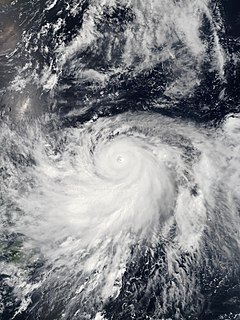The name Hanna or Hannah has been used for eleven tropical cyclones worldwide: five in the Atlantic Ocean and six in the Western Pacific Ocean. Hanna has also been used for one extratropical European windstorm.
The name Jose has been used for six tropical cyclones worldwide, five in the Atlantic Ocean and one in the Western Pacific Ocean, a typhoon that traversed the Philippine Atmospheric, Geophysical and Astronomical Services Administration (PAGASA) area of responsibility. The name was retired by PAGASA from future use in the region after that one use, and replaced with Josie for the 2018 Pacific typhoon season.
The name Agnes has been used for a total of sixteen tropical cyclones worldwide: one in the Atlantic Ocean, thirteen in the Western North Pacific Ocean, one in the South-West Indian Ocean, and one in the South Pacific Ocean.
The name Usagi has been used to name four tropical cyclones in the northwestern Pacific Ocean. The name was contributed by Japan and is the Japanese name of the constellation Lepus.
The name Wutip has been used to name four tropical cyclones in the Western Pacific Ocean. The name was submitted by Macau and means butterfly.

Severe Tropical Storm Halong, known in the Philippines as Severe Tropical Storm Cosme, was the fourth severe tropical storm named by the Japan Meteorological Agency (JMA) who are the Regional Specialized Meteorological Centre for the Northwestern Pacific Ocean. The Joint Typhoon Warning Center also recognised Halong as the fifth tropical depression, the fourth tropical storm as well as the third typhoon of the 2008 Pacific typhoon season.
The name Goni has been used to name four tropical cyclones in the Western Pacific Ocean. The variant Koni was used in 2003 before the spelling was corrected by the WMO Typhoon Committee. The name was contributed by South Korea and is a Korean word for swan.

The 2014 Pacific typhoon season was a slightly below average season, featuring 23 tropical storms, 11 typhoons, 8 super typhoons, and 7 Category 5 typhoons. The season's peak months August and September saw minimal activity caused by an unusually strong and a persistent suppressing phase of the Madden–Julian oscillation (MJO). The season ran throughout 2014, though most tropical cyclones typically develop between May and October. The season began with the development of Tropical Storm Lingling on January 18, and ended after Tropical Storm Jangmi which dissipated on January 1 of the next year.

The 2019 Pacific typhoon season was the costliest Pacific typhoon season on record, just ahead of the previous year. The season was fairly above-average, producing 29 named storms, 17 typhoons, and five super typhoons. It was an event in the annual cycle of tropical cyclone formation, in which tropical cyclones form in the western Pacific Ocean. The season ran throughout 2019, though most tropical cyclones typically develop between May and October. The season's first named storm, Pabuk, reached tropical storm status on January 1, becoming the earliest-forming tropical storm of the western Pacific Ocean on record, breaking the previous record that was held by Typhoon Alice in 1979. The season's first typhoon, Wutip, reached typhoon status on February 20. Wutip further intensified into a super typhoon on February 23, becoming the strongest February typhoon on record, and the strongest tropical cyclone recorded in February in the Northern Hemisphere. The season's last named storm, Phanfone, dissipated on December 29 after it made landfall in the Philippines. The accumulated cyclone energy (ACE) index of this season amounted to 269 units.
The name Songda has been used for four tropical cyclones in the Western North Pacific Ocean. The name was contributed by Vietnam, and is the name of the river Sông Đà in northwestern Vietnam.
The name Amy or Ami has been used for sixteen tropical cyclones worldwide: one in the Atlantic Ocean, two in the Australian region of the Indian Ocean, one in the South-West Indian Ocean, one in the South Pacific Ocean, and eleven in the Western Pacific Ocean.

This timeline documents all of the events of the 2014 Pacific typhoon season. Most of the tropical cyclones forming between May and November. The scope of this article is limited to the Pacific Ocean, north of the equator between 100°E and the International Date Line. Tropical storms that form in the entire Western Pacific basin are assigned a name by the Japan Meteorological Agency. Tropical depressions that form in this basin are given a number with a "W" suffix by the United States' Joint Typhoon Warning Center. In addition, the Philippine Atmospheric, Geophysical and Astronomical Services Administration (PAGASA) assigns names to tropical cyclones that enter or form in the Philippine area of responsibility. These names, however, are not in common use outside of the Philippines.

Typhoon Halong, known in the Philippines as Typhoon Jose, was a intense Typhoon in the Western Pacific basin in August 2014. It was the twelfth named storm and the fifth typhoon of the 2014 Pacific typhoon season. The storm reached its maximum intensity as a Category 5 super typhoon, making it the fifth strongest storm of the season, surpassed by Genevieve, Vongfong, Nuri and Hagupit.
The name Elsie has been used for 14 tropical cyclones in the Western Pacific Ocean, one tropical cyclone in the Australian region, and one tropical cyclone in the South-West Indian Ocean.
The name Luding was used for ten tropical cyclones by the Philippine Atmospheric, Geophysical and Astronomical Services Administration (PAGASA) and its predecessor, the Philippine Weather Bureau, in the Western Pacific Ocean.
This page is based on this
Wikipedia article Text is available under the
CC BY-SA 4.0 license; additional terms may apply.
Images, videos and audio are available under their respective licenses.



